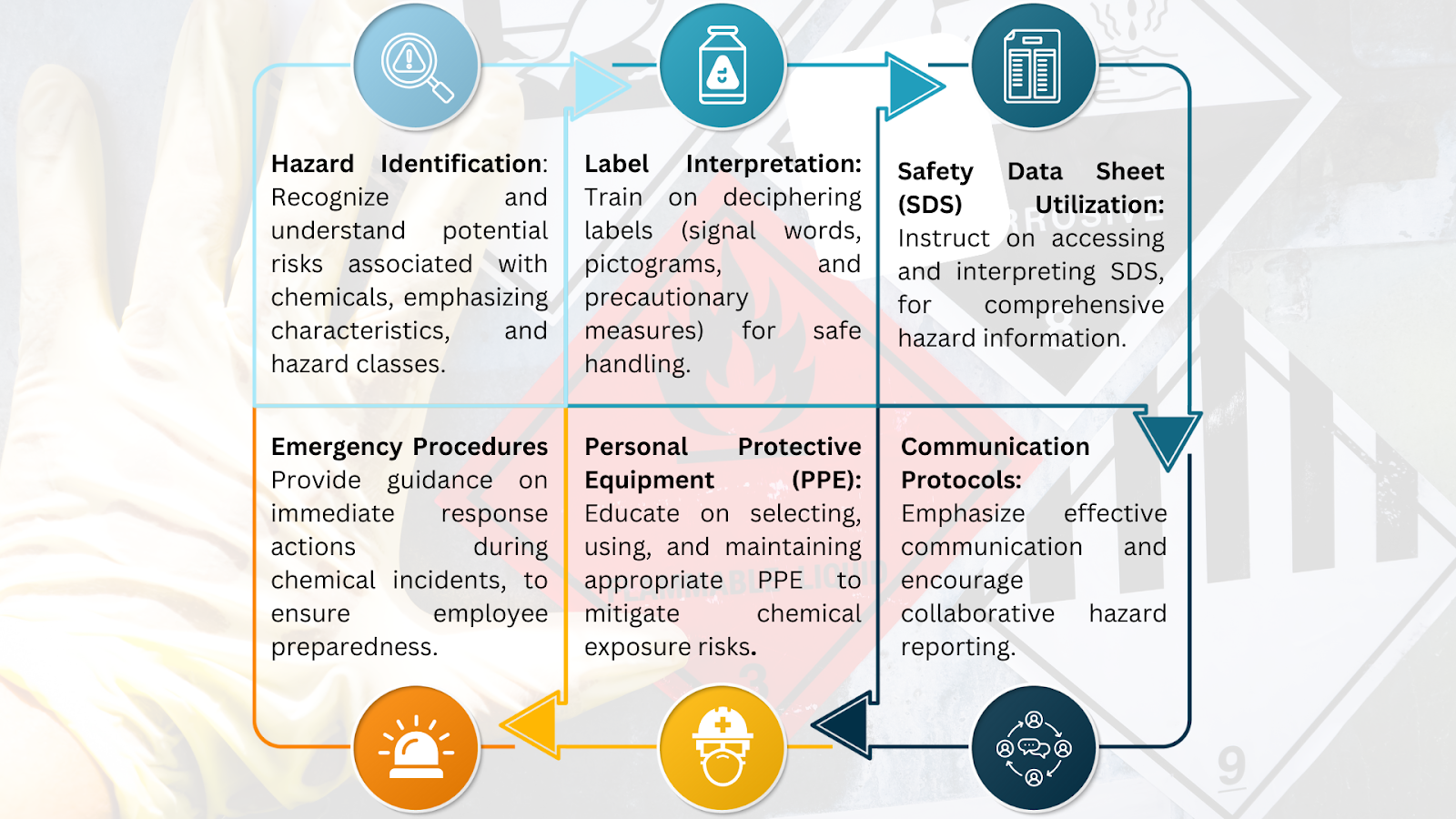.png)
The systematic approach of educating and warning people about the possible risks associated with chemicals in the workplace is known as "hazard communication." It entails sharing vital information about dangerous materials, such as their characteristics, safe handling techniques, and emergency protocols. This procedure guarantees that workers are aware of the hazards and are able to take the appropriate safety measures to keep others and themselves safe.
Hazard communication plays a critical part in preserving a safe and healthy work environment by raising awareness and comprehension.
OSHA's Hazard Communication Standard
The Hazard Communication Standard (HCS), established by the Occupational Safety and Health Administration (OSHA), is a crucial rule designed to protect employees from any risks associated with hazardous substances used in the workplace. The standard, which was introduced in 1983, had substantial changes in 2012 in order to conform to the Globally Harmonised System of Classification and Labelling of Chemicals (GHS).
- Safety Data Sheets: Employers are required by the HCS to evaluate and disclose the hazards related to chemicals used in the workplace. This entails producing and distributing Safety Data Sheets (SDS) which includes information ‘such as the properties of each chemical; the physical, health, and environmental health hazards; protective measures; and safety precautions for handling, storing, and transporting the chemical.’ After the revision, Safety Data Sheets were mandated to have a specified 16-section format.
- Labels and Pictograms: Chemical producers, importers, and distributors are required by the HCS to make sure that every container containing hazardous chemicals that is taken outside of the workplace is tagged, labeled, or otherwise identified with the following information: ‘product identifier; signal word; hazard statement(s); precautionary statement(s); and pictogram(s); and name, address and telephone number of the chemical manufacturer, importer, or other responsible party.’
One of the main components of the HCS is employee training, which guarantees that workers are aware of the hazards, can properly use SDS, and understand label aspects. By providing personnel with the knowledge to make educated decisions regarding the handling, storage, and use of hazardous chemicals, this all-encompassing strategy lowers the possibility of mishaps and diseases linked to chemical exposure.
The HCS not only improves workplace safety but also opens up commerce between countries by harmonizing standards for hazard communication. OSHA's Hazard Communication Standard is essential in fostering a culture of understanding and responsibility about chemical dangers and a safe work environment because of its proactive procedures.
The Importance of Hazard Communication
Hazard Communication (HazCom) offers thorough training to employees about chemical risks, which greatly improves workplace safety. By being able to recognize and react to possible hazards, people can lessen the chance of mishaps and injuries. A well-executed HazCom program promotes accountability and awareness, making the workplace safer and better informed. Adherence to HazCom regulations guarantees legal compliance, thereby reducing the likelihood of fines and legal complications. In the end, HazCom is essential for enhancing general well-being, reducing health hazards from chemical exposure, and making the workplace safer and more productive.
Elements of HazCom Training

Implementing HazCom in the Workplace
Understand the Standards and the Employees
Acquire knowledge of the standard and designate accountable personnel to lead the implementation of Hazard Communication, guaranteeing that roles and responsibilities are well understood within the company.
Written HazCom Programme
Create and execute a thorough written Hazard Communication Programme that outlines safety precautions, protocols, and procedures to guard against possible chemical hazards at work.
Proper Labeling
Make sure that every container has the proper labeling, which includes important details about dangerous substances, creating a safer atmosphere, and raising staff awareness of potential hazards.
Maintain Safety Data Sheets (SDSs)
Keep Safety Data Sheets (SDSs) for every chemical that is used, making sure that information about its characteristics, risks, and safe handling practices is easily accessible and current.
Employee Training
Employees should be informed and trained in Hazard Communication, with a focus on the importance of label interpretation, SDS comprehension, and safe practices in order to reduce risks and guarantee a secure work environment.
Evaluation and Reassessment
Maintain a regular review and evaluation of your Hazard Communication Programme, making adjustments for modifications to chemicals, practices, or laws, and always enhancing employee safety precautions.
Towards Workplace Safety with SafetyConnect
Prioritizing workplace safety is integral to the success of any business. While Hazard Communication (HazCom) is crucial, other facets contribute to ensuring employee well-being.
SafetyConnect recognizes the multifaceted nature of safety and offers a range of products designed to leverage technology. Our solutions streamline safety procedures and provide actionable insights. If you're keen on fostering a culture of safety in your company, schedule a demo with us to explore how SafetyConnect's innovative products can enhance workplace safety, contributing to both employee welfare and business prosperity.



.png)

